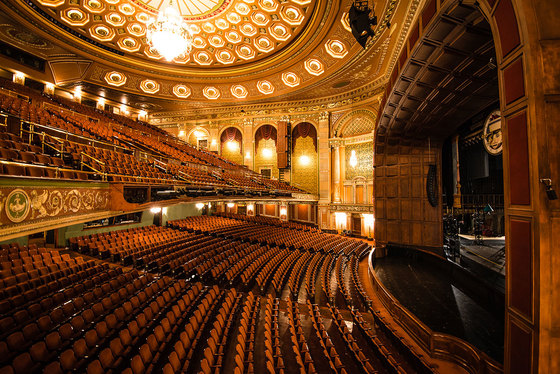Benedum Center Information
The Benedum Center (formerly known as The Stanley Theatre), is a Pittsburgh Cultural Trust theater situated in the heart of Pittburgh’s cultural district. With a 2,800 seat capacity, the theater showcases some of the best Broadway shows in America.

About Benedum Center
The Benedum Center was named after the Claude Worthington Benedum Foundation, which made the largest contribution toward the restoration of the grand building. Owned and operated by the Pittsburgh Cultural Trust, the restored 2,800-seat theater in Pittsburgh is a centerpiece of the Cultural District. From concerts to Broadway musicals, the Benedum Center hosts a wide range of regional, national and international performance arts that entertains guests from all over the world. The theater is formerly known as the Benedum Center for the Performing Arts and has earned a place on the National Register of Historic Places as well as been dubbed “Number One Auditorium in the U.S.” by Billboard several times!
The Benedum Center for the Performing Arts stands as a cornerstone of Pittsburgh’s vibrant Cultural District. This magnificently restored 1920s movie palace now serves as the city’s premier performing arts venue and home to three prestigious resident companies: the Pittsburgh Opera, Pittsburgh Ballet Theatre, and Pittsburgh Civic Light Opera. With over 2,800 seats, the Benedum Center in Pittsburgh hosts Broadway touring productions, live concerts, opera, and ballet performances.
The venue’s opulent Art Deco interior features a legendary 4,700-pound crystal chandelier, original light fixtures, and meticulously restored period details. Originally opened as the Stanley Theatre on February 27, 1928, the building underwent a $43 million renovation and reopened on September 25, 1987, as a National Register of Historic Places landmark.
Billboard magazine has recognized it multiple times as the “Number One Auditorium in the U.S.” Located at 237 7th Street in downtown Pittsburgh’s Cultural District, the theater combines historic grandeur with modern amenities and comprehensive accessibility features.
The Benedum Center represents the successful preservation of Pittsburgh’s theatrical heritage while serving the contemporary needs of performers and audiences alike. The venue’s transformation from a struggling movie palace facing potential demolition to a thriving performing arts center showcases the power of community commitment to cultural landmarks.

Benedum Center History
The Benedum Center for the Performing Arts, previously known as the Stanley Theatre, boasts a vibrant history. In 1928, the grand venue, designed by the Philadelphia architectural firm Hoffman-Henon, opened its doors as a deluxe movie palace. It stood tall with a seating capacity of 3,800, soon becoming the largest movie theater in Western Pennsylvania. The Stanley Theatre was known as the home of entertainment, providing a welcome lift of spirits during the Great Depression.
Over the years, the theater gained recognition for hosting major acts, from the iconic Frank Sinatra’s performance in 1943 to the appearances of bands like War and King Crimson in 1974. Known as “Pittsburgh’s Palace of Amusement,” this grand venue earned the title of “Number One Auditorium in the U.S.” by Billboard. In 1977, DiCesare and Engler Productions bought the building, turning it into an epic Rock and Roll hall.
During the mid-1980s, the theater had a revamp. A whopping $43 million went into transforming the old movie palace into the vibrant Benedum Center for the Performing Arts that is celebrated today. They kept the classic design but added modern support facilities, expanded the stage, and enhanced the acoustics, turning it into a full-fledged performing arts center. The late H.J. Heinz II was a key player in the theater’s restoration, especially when it came to the centerpiece – a grand, 4,700-pound chandelier hanging in the dome above the balcony. Fun fact: There are more than a whopping 90 crystal chandeliers, torchieres and sconces in the venue!!
The Benedum Center opened on Friday 25th September 1987, with a show called “Purely Pittsburgh,” which was written by Dan Langen and produced by Mandy Levine. Since its transformation into the Center, it has become a vibrant cultural hub with a 2,800 seat capacity. It has housed the city’s top performing arts companies such as the Pittsburgh Opera, Pittsburgh Ballet Theatre, and Pittsburgh Civic Light Opera, as well as had the pleasure of hosting a wide range of events, from TV concerts and popular game shows like Wheel of Fortune right through to industry legends. The Benedum Center’s iconic history has seen none other than Prince kicking off his Controversy Tour there (1981), an epic performance by the Grateful Dead (1979), Bob Marley & The Wailers’ historic last show (1980), and the 50th celebration of the rock powerhouse Kansas (2023).
But that’s not all! The theater was also the star of “Live Forever: September 23, 1980”. Released in February 2011, this was a live album by Bob Marley & The Wailers’ last performance that was recorded at the Stanley Theatre during the Uprising Tour. If that isn’t enough, the venue even made it onto the silver screen during HBO’s Boardwalk Empire, hosting a tap dancing act during its season 4 premiere. It also featured in the 2006 mockumentary film “Pittsburgh,” directed by Jeff Goldblum, which followed his involvement in the Pittsburgh Civic Light Opera production of The Music Man.
In 1997, the global sensation Bruce Springsteen ignited the venue with the megahit Born in the U.S.A., meanwhile legendary acts like Mariah Carey, Hozier, Kansas, The Beach Boys, 2Chainz, Chris Rock, and Dolly Parton made history on the stage at the turn of the millennium.
The Benedum Center for the Performing Arts carries a rich history spanning nearly a century, reflecting Pittsburgh’s cultural evolution and the changing role of performing arts venues in American life.
The Stanley Theatre Era: 1928 to 1987
James Bly Clark, a prominent theater tycoon who played a role in founding Metro-Goldwyn-Mayer (MGM), financed the construction with a $3 million investment. Clark commissioned Hoffman-Henon, a Philadelphia architectural firm among the most prominent theater designers in early 20th-century America, to create an Art Deco masterpiece that complemented the adjacent Clark Building office tower.
The Stanley Theatre opened on February 27, 1928, with Governor John S. Fisher, Pittsburgh Mayor Charles H. Kline, and Paramount Studios President Adolph Zukor attending the grand opening. The theater premiered “Gentlemen Prefer Blondes,” starring Ruth Taylor, on screen, complemented by Anatole Friedland’s “Revue” on stage.
The Stanley served as Pittsburgh’s premier first-run house for Warner Bros. film releases while hosting live performances by Frank Sinatra (who performed there in 1943), Benny Goodman, Cab Calloway, and the Andrews Sisters. In 1936, the theater flooded, destroying the treasured Wurlitzer organ, though it continued operating for decades.
In 1977, DiCesare Engler Productions transformed the theater into a rock concert venue, hosting the Grateful Dead, Bob Marley & The Wailers, Prince, the Clash, and Journey. During this era, Billboard Magazine recognized the Stanley Theatre multiple times as the “Number One Auditorium in the U.S.”
Transformation and Renovation: 1984 to 1987
In 1984, the Pittsburgh Cultural Trust acquired the Stanley Theatre. H.J. Heinz II, who had previously led the renovation of Heinz Hall, championed saving the building. The renovation ultimately cost $43 million, including the construction of a new building at the rear (the Clark Extension) with stage extensions and modern support facilities.
The interior underwent meticulous restoration as well, with preservation specialists restoring original features to their 1928 appearance. More than 90 crystal chandeliers, torchieres, and sconces were refurbished and reinstalled.
The massive 4,700-pound Czechoslovakian crystal chandelier that’s 20 feet high by 12 feet wide underwent a complete restoration, dedicated to H.J. Heinz II. The theater still features 1,500 feet of brass railing, most of which is original to the 1928 construction.
Reopening as the Benedum Center: 1987
On September 25, 1987, the theater reopened as the Benedum Center for the Performing Arts, named for the Claude Worthington Benedum Foundation, which made the largest financial contribution toward the restoration. The opening event, “Purely Pittsburgh,” featured music by Pittsburgh composers and performers.
The newly christened Benedum Center became the permanent home for Pittsburgh Opera, Pittsburgh Ballet Theatre, and Pittsburgh Civic Light Opera. In 1985, the building was listed on the National Register of Historic Places, recognizing its architectural significance as an early example of Art Deco design in Pittsburgh and its importance to the city’s cultural history.

Broadway Shows
The Center now hosts some of the biggest and best Broadway shows in the world including:

Annie
CATS
Phantom of the Opera
Singing In The Rain
Footloose
Evita
These are just some of the shows at the Benedum Center, for complete listings on events head on over to the events or tickets pages.
